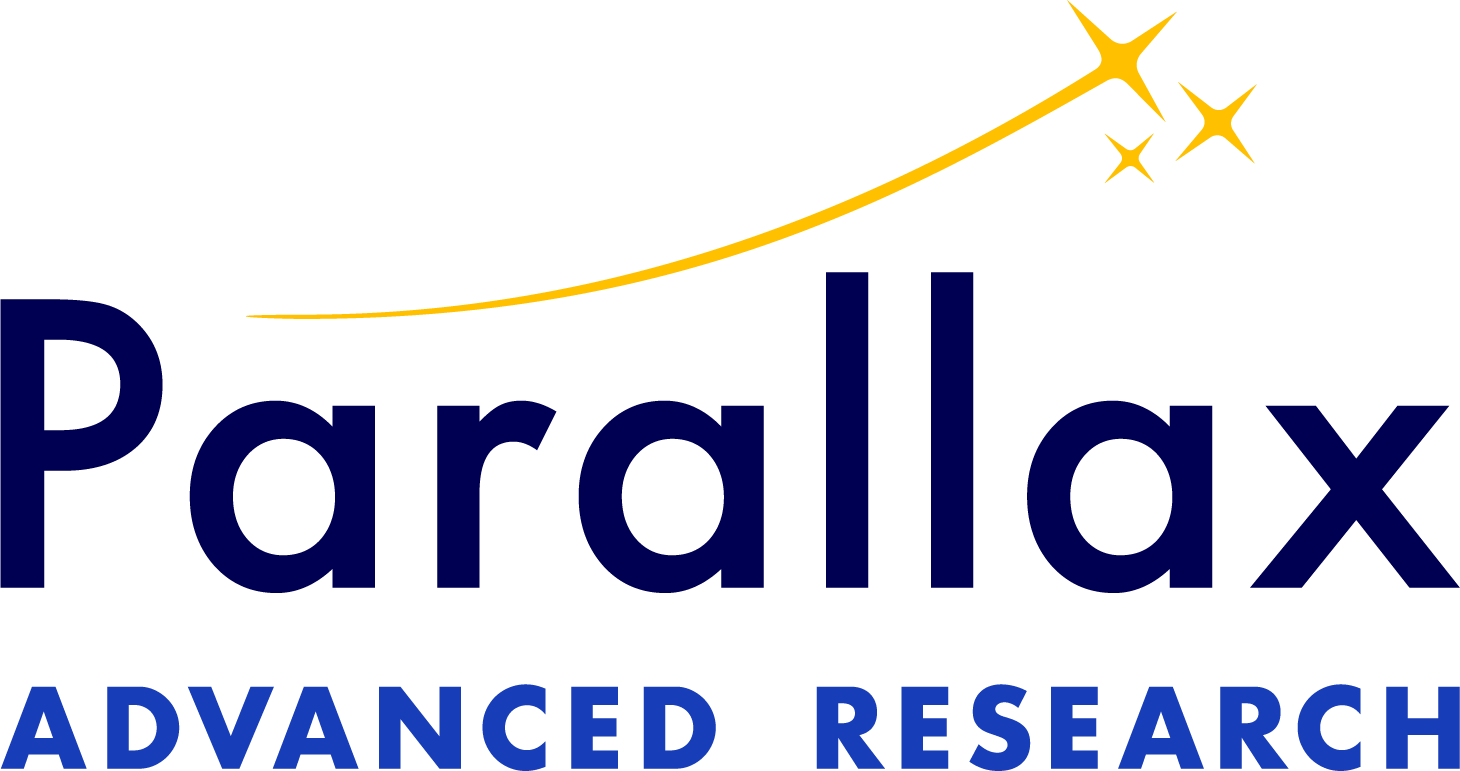Dayton, Ohio–Advanced Air Mobility (AAM) is a new era of aviation and an emerging capability that is transforming airspace technology as it applies to airborne travel, cargo shipping, and urban and rural infrastructure. It involves innovators, experts, and policymakers from industry, academia, and the government throughout the United States and the world to innovate AAM technologies and capabilities for the benefit of society. Parallax Advanced Research, a 501(c)3 nonprofit private research institute headquartered in Dayton, Ohio, possesses unique expertise that is helping evolve the AAM industry. Parallax supports this national effort via three thrusts: (1) it facilitates industry-academia-led research and development projects that fulfill government AAM needs and capabilities; (2) its Unmanned Aircraft Systems (UAS) researchers and engineers work with the Department of Defense on UAS initiatives and programs that enable commercial AAM and industry growth; and (3) it collaborates with its affiliated 501(c)3 private nonprofit research institute, the Ohio Aerospace Institute, and Manufacturing Works on The Center for Advanced Air Mobility Initiative (CAAM-I), which is designed to accelerate Northeast Ohio Manufacturers' access to and engagement with unmanned vehicle production and electric vehicle transformation.
Driving Innovation and Collaboration: Parallax Empowers Ohio and the Nation in AAM
Parallax manages entrepreneurial and research networks that foster collaboration among academia, government, and industry to advance and commercialize AAM, UAS, and other technologies for Ohio and beyond. The Ohio Federal Research Network (OFRN) is one such program that Parallax established and has managed since 2014, in collaboration with The Ohio State University and funded by the Ohio Department of Higher Education. OFRN plays a crucial role in stimulating Ohio's innovation economy by creating vibrant university-industry research collaborations that are aligned with the needs of Ohio's federal laboratories. This program drives the development of cutting-edge technologies, some of which enable the AAM and UAS ecosystem, that fuel job growth within the state.
Through OFRN, Parallax experts work closely with key stakeholders, such as the Air Force Research Laboratory, Naval Medical Research Unit-Dayton, National Air and Space Intelligence Center, National Aeronautical and Space Administration's Glenn Research Center, and the Ohio National Guard, to conduct research and development focused on AAM, UAS, and other innovations within Ohio. Many of the projects are now instrumental in assisting organizations like the Federal Aviation Administration (FAA), NASA, and industry as they tackle the complex technological challenges associated with the evolution of AAM. These projects encompass groundbreaking research and technology demonstrations in areas such as power propulsion, low-altitude airspace management, noise reduction, and cybersecurity.
Ohio Federal Research Network AAM Tech Highlights
Ghostwave Inc. Integrated Optical-radar Sensor Fusion System
GhostWave Inc.’s Unmanned Aerial Vehicles (UAV) Log Viewer of Evasive Maneuvers
GhostWave Inc.'s integrated optical-radar sensor fusion system, developed with funding from the Ohio Federal Research Network's Sustaining Ohio’s Aeronautical Readiness and Innovation in the Next Generation (SOARING) Initiative, addresses the growing need for UAV safety and compliance with the FAA’s remote identification rules. The system utilizes radio frequency noise technology to detect and classify potential threats in a UAV's flight path, helping pilots avoid collisions and ensuring the safety of other aircraft, people, and property. The technology, patented by The Ohio State University and exclusively licensed to GhostWave Inc., showcases the company's commitment to providing essential safety solutions for UAV operators. As UAV usage expands and integrates into national airspace, this innovative technology brings awareness and mitigates risks, contributing to the broader goal of safe and responsible UAV operations. Learn more here.
CAL Analytics UAS Traffic Management (UTM) Platform
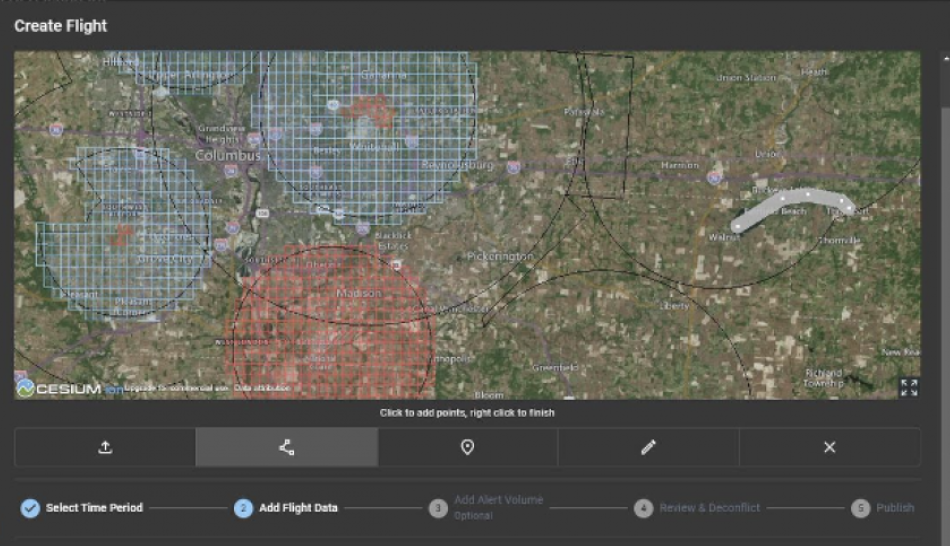
CAL Analytics UTM Platform
Ohio is actively working to become a major player in the emerging field of electric vertical take-off and landing (eVTOL) vehicles and air taxis. They are making substantial investments in infrastructure and regulations to support this effort. Ohio's goal is to lead the way in developing and regulating these futuristic electric flying vehicles, which could potentially revolutionize urban transportation and serve as a model for other regions.
The Ohio Department of Transportation (ODOT) has selected CAL Analytics as its service provider for unmanned aircraft systems. CAL Analytics will use its UAS Service Supplier (USS) platform for operations across the state. ODOT's decision to work with CAL Analytics comes after the successful development of a contingency management system for Ohio UAS Operations, which was funded by the Ohio Federal Research Network. ODOT will benefit from CAL Analytics' USS platform, which provides centralized monitoring, management, and improved situational awareness for UAS operations, including those beyond visual line-of-sight and within visual line-of-sight. CAL's technology will help ODOT advance its unmanned aircraft operations, focusing on safety, situational awareness, and coordination during emergencies. This partnership underscores Ohio's leadership in UAS technology and its dedication to innovation and research in this field.
Furthermore, the Ohio Department of Transportation's DriveOhio initiative is working on infrastructure development for the National Advanced Air Mobility Center at Springfield Airport. They are utilizing advanced air traffic control technologies. CAL Analytics, with support from the Ohio Federal Research Network, is contributing to this effort by creating a Contingency Management Platform (CMP) to enhance the safety and management of unmanned aircraft systems (UAS) operations in Ohio's airspace. This platform will facilitate the growth of the AAM industry in the state. Learn more here.
Kent State University UAS power source
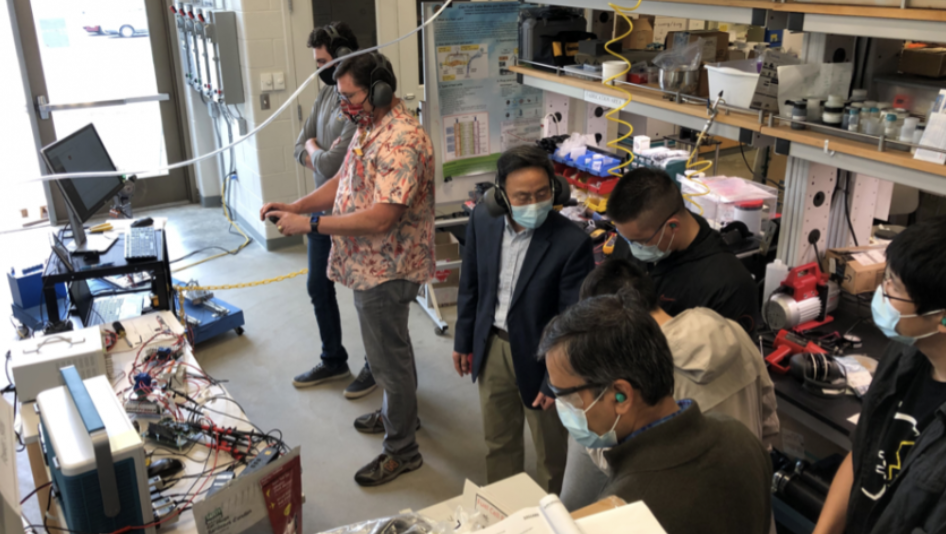
Kent State University project team demonstrates the power source for UAS to extend flight time and increase payload capabilities.
Kent State University, in collaboration with other research institutions and industry partners, has developed a lightweight hybrid fuel cell/battery/capacitor system that enhances the flight time and payload capacity of vertical takeoff and landing (VTOL) UAVs. The project, funded by the Ohio Federal Research Network, aimed to address the limitations of current onboard power sources for UAVs. The hybrid power successfully flew the VTOL UAV for 118 minutes continuously at the Kent State Airport, with only 40% of the fuel tank capacity, surpassing the typical 20–30-minute flight time of commercial drones. The hybrid power source was successfully tested for 12 hours of operation in the Fuel Cell lab at Kent State. The VTOL system has significant applications for both military and commercial sectors, including package delivery, surveillance, wildfire inspections, and emergency response. The OFRN played a crucial role in funding and facilitating collaborations for the project, supporting its successful completion. The development team is looking for opportunities to fly higher and longer. Learn more here.
Parallax's Extensive UAS Expertise Fuels AAM Innovation to support the Integration and Synergy of Defense and Commercial Capabilities
The Parallax Research and Development Team, comprised of UAS and aerospace experts, possesses decades of experience contributing critical artificial intelligence and human-machine teaming expertise to the Department of Defense (DoD) and U.S. Air Force on their UAS initiatives and programs. Parallax’s unmatched multi-UAS command and control test and evaluation proficiencies have advanced the DoD’s capabilities concerning semi-autonomous, remotely piloted aircraft and single-operator control of multiple UASs.
For example, Parallax's Mobile Testing Evaluation Center (MTEC) is a state-of-the-art mobile lab that travels across the USA for comprehensive unmanned aircraft systems (UAS) testing, from software to sensors. Established in 2012, MTEC is a self-sufficient, 43-foot-long facility with cutting-edge technology and the capability to conduct various flight tests. MTEC's services include writing test plans, equipment selection, logistics management, and coordination with test ranges. It has been used at 16 locations across the USA, amassing over 1,000 flight hours and testing various UAS, including multi-UAS control by a single operator.

Parallax Advanced Research’s Mobile Testing Evaluation Center (MTEC) is an advanced computer-equipped mobile lab that travels to various locations throughout the USA to conduct simulated and live UAV flight tests, from software to sensors to Unmanned Aircraft Systems (UAS).
Parallax’s Mobile Testing Evaluation Center enables UAS flight testing for national missions here.
Among the major focus areas of AAM development is the development of affordable and effective low-altitude airspace infrastructure that helps the industry reach a functional stage. The safe integration of these aircraft into a new, more comprehensive air traffic management system that is separate from, but complementary to, the FAA's Air Traffic Management (ATM) system called Unmanned Aircraft System Traffic Management (UTM) is of national importance. Low-altitude airspace infrastructure includes the sensors, controls, and communications that integrate AAM safely into the operational airspace. Parallax’s work with the DoD directly complements these civil efforts.
Parallax Experts Involved in State- And National-level Policy and Regulatory Discussions
Parallax actively collaborates with influential organizations, including NASA, FAA, state legislatures, airports, industry leaders, universities, and community stakeholders, to shape the future of AAM through policy, regulation, and community engagement. They envision AAM as a transformative ecosystem with broad economic and societal implications, leveraging their expertise gained from working with the U.S. Air Force to guide the industry's transition from military to civilian use, ensuring safe and impactful integration into our daily lives.
Dr. Darrell Lochtefeld, VP of Intelligence Systems at Parallax, said, "Commercializing transformative technology requires merging multiple elements: technology, regulation, and applications. Parallax excels in this, thanks to our expertise in connecting industry, academia, and the U.S. Government, making us uniquely qualified to transition DoD technologies into civilian and commercial markets."
Collaborating with NASA: A Grassroots Approach
One noteworthy initiative that highlights Parallax's commitment to AAM is its participation in the NASA Grand Challenge. This national solicitation selected a few states, including Ohio, to build a roadmap for states and localities to engage with local communities and governments to help inform and educate on the benefits and opportunities that AAM will provide. AAM. Parallax’s aerospace and defense experts led the community integration section of Ohio's team. Their mission was to understand community perceptions, awareness, and priorities regarding AAM. By canvassing various stakeholders, from metropolitan planning organizations to local airports, Parallax engaged many local stakeholders across the state to provide valuable grassroots insights to NASA.
Supporting the FAA: Navigating the Regulatory Pyramid
Parallax's involvement in shaping AAM regulations extends to support for the FAA's UAS Integration Research Functional Framework. The key to success in this endeavor, on the part of Parallax Advanced Research, is active participation in national events and forums where industry leaders converge. Forums like the Association for Uncrewed Vehicle Systems International (AUVSI) provide a platform for Parallax to exchange ideas, identify opportunities, and establish connections with FAA, NASA, and industry experts. The FAA reauthorization bill, currently under consideration, is another significant area of focus. Parallax is working behind the scenes to insert ideas, strategies, and research capabilities into this legislation. Their goal is to facilitate the development of safety rules and regulations for AAM.
View how Parallax supports the FAA UAS Integration Research Functional Framework here.
Building the AAM Appalachian Corridor: Cross-Border Challenges
One of Parallax's most innovative contributions to AAM policy is the concept of an "AAM Appalachian Corridor." This corridor spans from southern Ohio through West Virginia, serving as a real-time operational environment for AAM technologies. This groundbreaking project addresses complex challenges when AAM vehicles cross state borders. Different states have distinct laws, regulations, and policies, posing unique obstacles. Parallax's focus on the Appalachian region demonstrates its commitment to solving national challenges at the grassroots level and advancing the AAM industry.
Addressing Community Needs and Safety Concerns
Public acceptance and awareness of AAM are crucial for its successful integration. Parallax recognizes this challenge and emphasizes hands-on grassroots engagement, particularly with students. By reaching out to K-16 students, they aim to demystify AAM technologies and garner community support. Additionally, Parallax is actively participating in shaping legislation regarding the use and operation of drones, considering factors such as privacy and noise concerns.
The Vision for AAM's Regulatory Future
Parallax envisions AAM as an entire ecosystem of transformative technologies. As the industry matures, it will touch every facet of the economy and society. This includes logistics, delivery services, and even passenger transportation. With decades of expertise derived from its work with the U.S. Air Force, Parallax is uniquely positioned to guide the industry's evolution from a military to a civilian airspace. Their involvement in AAM policy and regulation ensures a safe, efficient, and impactful integration of this groundbreaking technology into our daily lives.
Ohio Aerospace Institute and Parallax Advanced Research Collaborate to Drive AAM Development in Ohio
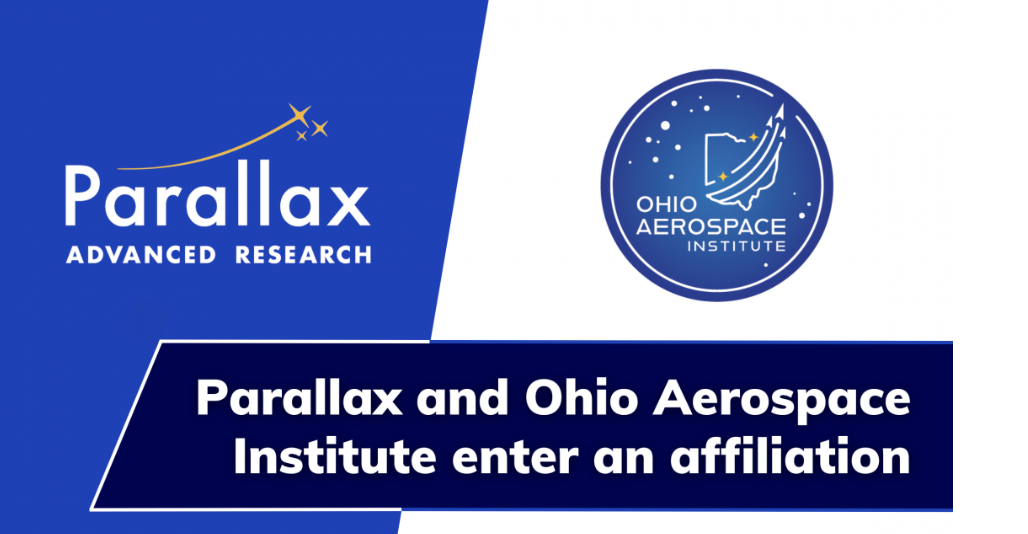
The Ohio Aerospace Institute, which became wholly affiliated with Parallax Advanced Research on January 1, 2023, has formed a strategic partnership to accelerate the development of AAM in Ohio. This collaboration establishes a dedicated statewide applied research team focused on advancing AAM technologies across all state regions. Together, OAI and Parallax aim to help position Ohio as a prominent hub for AAM advancements, shaping the future of aviation on a global scale. Through their combined efforts, they foster industry advocacy, expand the global aerospace market, and create opportunities for workforce development and small business growth.
“This affiliation has directly resulted in bringing together the Southwest Ohio defense ecosystem and the Northeast Ohio aerospace supply chain while creating and expanding applied research linkages across Ohio for aerospace, space, energy, advanced manufacturing, materials sciences, physical sciences, microelectronics, medical, and UAS research and development,” said Dennis Andersh, Parallax president and CEO.
The Center for Advanced Air Mobility Initiative (CAAMI)
The Center for Advanced Air Mobility Initiative (CAAMI), managed by Manufacturing Works and The Ohio Aerospace Institute, is a recipient of the U.S. Economic Development Administration “Build to Scale Venture Challenge” grant. CAAMI serves as a virtual accelerator, primarily focusing on fostering the growth of small businesses and entrepreneurs through outreach, commercialization, and partnership initiatives within the AAM sector. An important aspect of CAAMI's mission is to support underrepresented small businesses, including those owned by minorities, women, and veterans. Stay up to date with CAAM-I by signing up for the blog here.
CAAMI has successfully engaged with more than 65 companies, with over 70% of them being minority, women, and/or veteran-owned businesses, demonstrating CAAMI's commitment to diversity and inclusion in the AAM industry. CAAMI has also facilitated the growth of several notable businesses through its initiatives, including:
UAVistas
UAVistas is a Minority Business Enterprise and Women's Business Enterprise firm. The company required technology commercialization, technical assistance, and funding support. CAAMI provided pitch coaching, which helped UAVistas secure $50,000 in funding from the Glide Innovation Fund. Additionally, CAAMI supported UAVistas in establishing partnerships with local school systems through contracting support and outreach assistance. Learn more about UAVistas here.
The innovative minds in advanced air mobility recently came together to uncover opportunities to get more drones in the air.
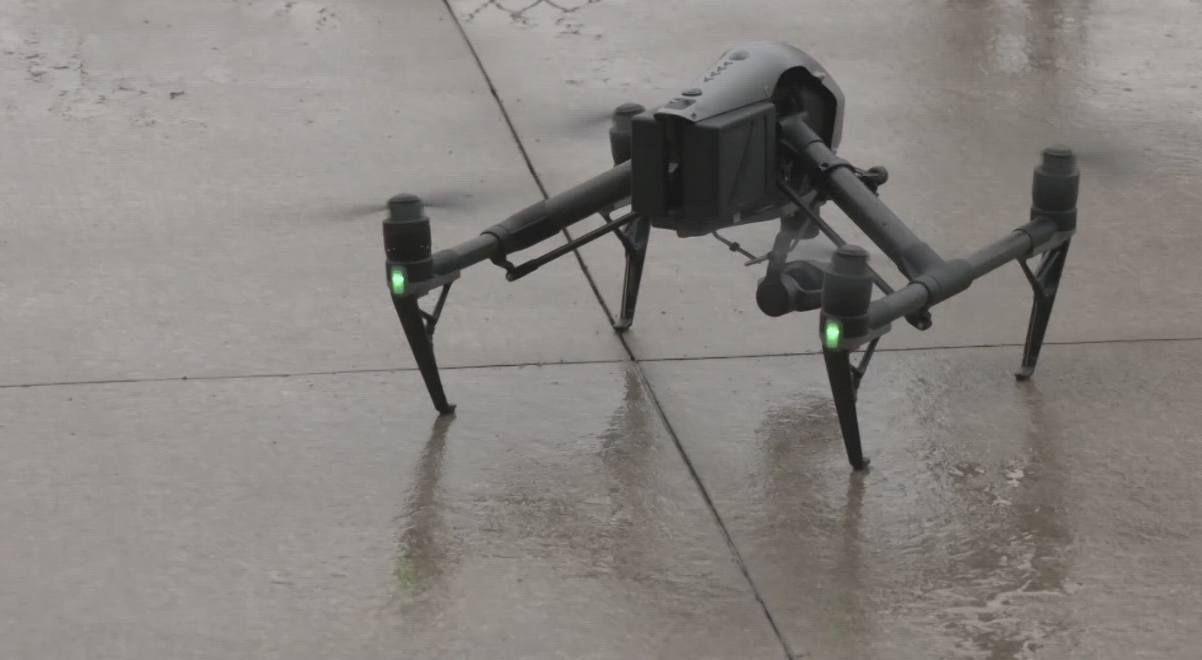
Aampersand
Aampersand is an MBE seeking seed funding to accelerate the development of their minimum viable product focused on providing a sole information platform to help facilitate drone airspace navigation traffic and deliveries. CAAMI offered support by assisting Aampersand in navigating the Small Business Innovation Research program and NASA resources, helping them find potential funding sources for their innovative endeavors. Learn more about Aampersand here.
The Technology House
This Women's Business Enterprise company required access to moisture analyzer equipment to enhance the quality of their product development. CAAMI is currently working on obtaining capital support for The Technology House through the Ohio Defense Manufacturing Community. This support strengthens the company's internal capacity and competitiveness in securing government contracts, especially those with specific moisture analyzer equipment requirements. Learn more about The Technology House here.
Allegro Tech
Another Minority Business Enterprise, Allegro Tech, faced challenges related to technology commercialization and funding. CAAMI provided navigational support for the Air Force Tech Connect Portal and assisted in pursuing a United States Air Force Small Business Innovation Research Open Topic grant. These efforts aimed to accelerate Allegro Tech's technological advancements and growth. Learn more about Allegro Tech here.
“CAAMI's dedication to supporting diversity and equity among small businesses and entrepreneurs in the AAM sector is evident through its impactful initiatives and collaborations, ensuring this sector’s continued growth and success,” said Anthony Gillespie, Director of Technology-Based Economic Development, Ohio Aerospace Institute.
Work with Parallax to Propel the Future Of AAM
Parallax seeks to connect with nationwide industry, academia, and U.S. Government entities to collaborate on AAM technology development, infrastructure planning, and policy. Reach out to Parallax here.
###
About Parallax Advanced Research and the Ohio Aerospace Institute
Parallax Advanced Research is a 501(c)(3) private nonprofit research institute that tackles global challenges through strategic partnerships with government, industry, and academia. It accelerates innovation, addresses critical global issues, and develops groundbreaking ideas with its partners. With offices in Ohio and Virginia, Parallax aims to deliver new solutions and speed them to market. In 2023, Parallax and the Ohio Aerospace Institute (OAI) formed a collaborative affiliation to drive innovation and technological advancements in Ohio and for the Nation. OAI is pivotal in advancing the aerospace industry in Ohio and the nation by fostering collaborations between universities, aerospace industries, and government organizations and managing aerospace research, education, and workforce development projects. More information about both organizations can be found at the Parallax and OAI websites.
